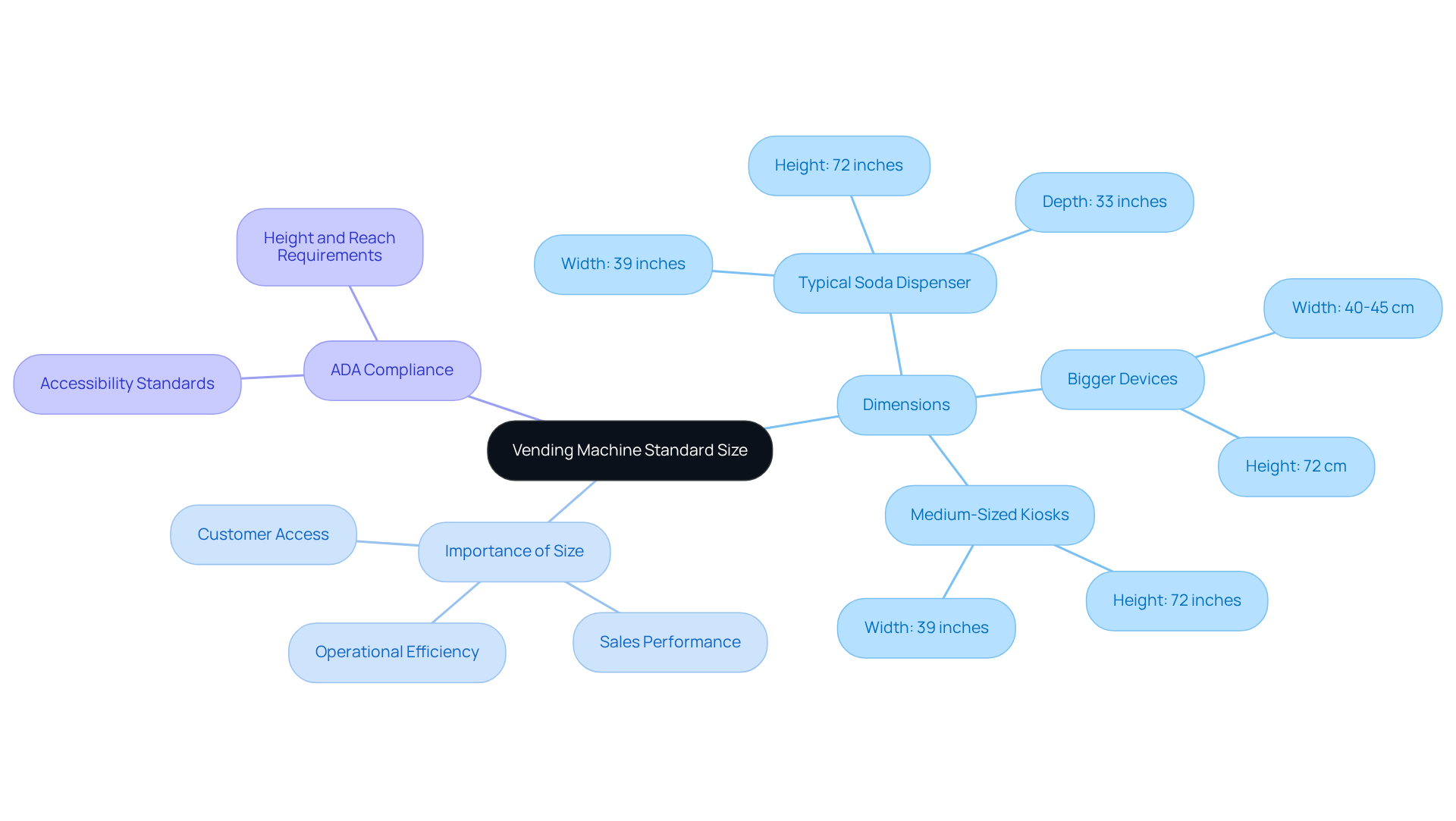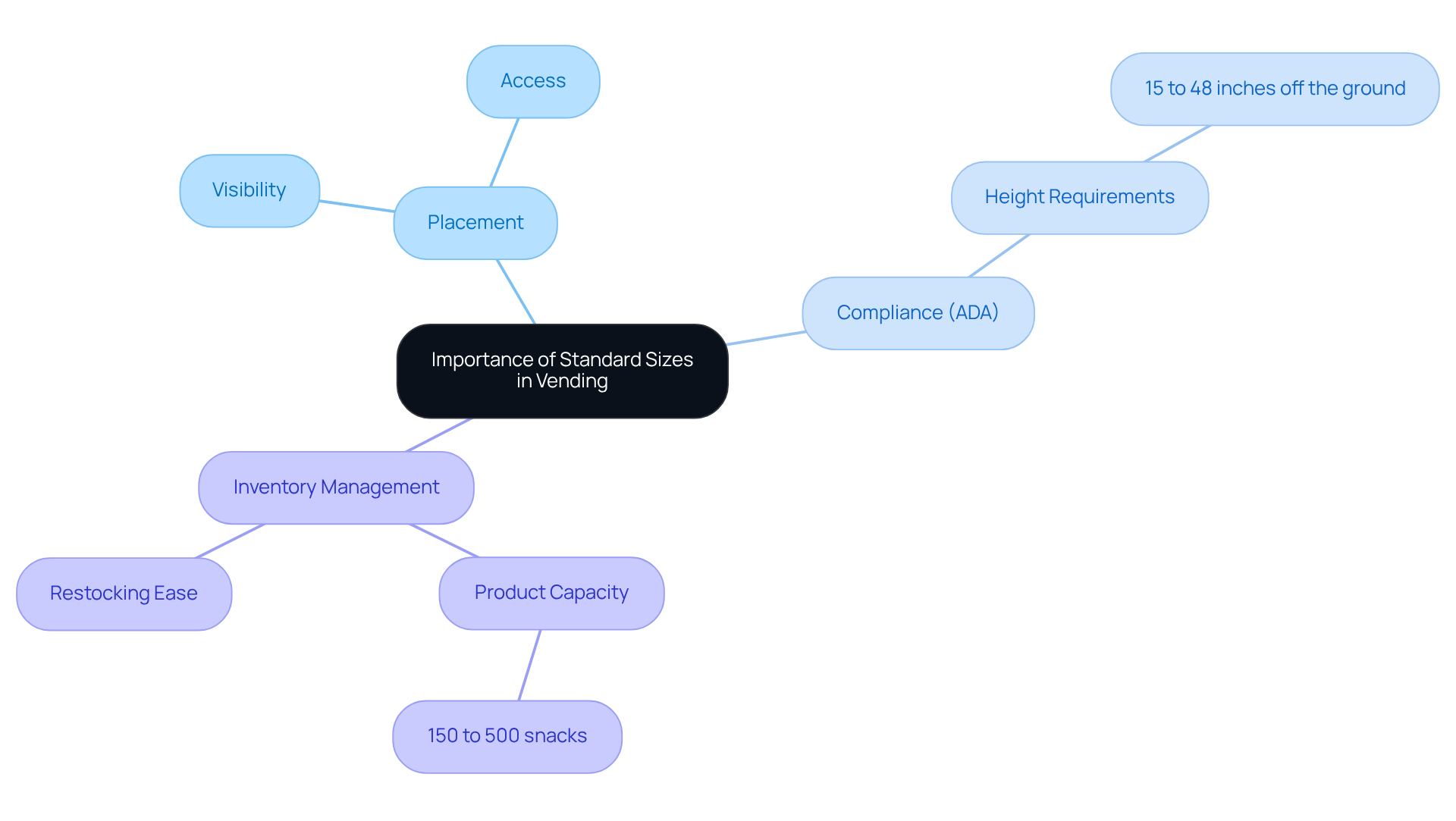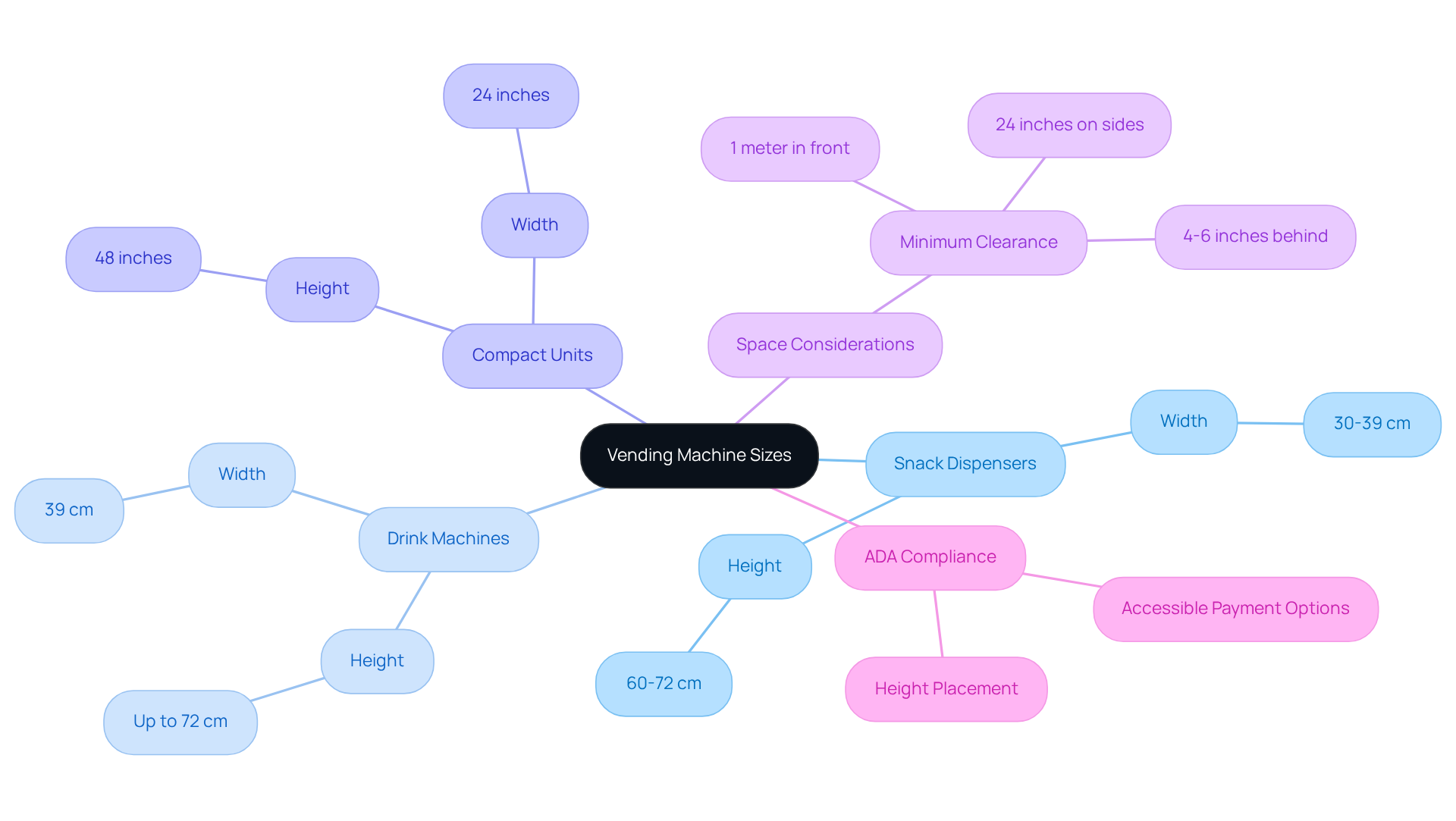Overview
Have you ever thought about how important it is to know the standard sizes of vending machines? Understanding these dimensions is key for placing them just right, managing your inventory effectively, and even following accessibility laws.
Here’s the thing: the size of your vending machine can really impact sales performance and customer access. When you choose the right dimensions, you not only boost visibility but also cater to a variety of customer needs.
So, if you want to enhance your operations, take a moment to consider how proper sizing can make a difference. It’s a simple step that can lead to better results in your vending business!
Introduction
You know, understanding the dimensions of vending machines isn’t just about how they look; it’s really about how well they work and how successful they can be. The standard sizes determine how much product you can fit inside, where you can place the machines, and how easy they are for all kinds of customers to access.
But here’s the thing: with technology and consumer preferences changing so fast, are these standards really keeping up with what modern retail needs? This article dives into why those standard sizes matter, looking at how they affect sales, compliance, and operational efficiency. Plus, we’ll question whether the current dimensions truly meet the needs of today’s market.
Let’s break it down together and see what we can learn!
Define Vending Machine Standard Size
When you think about dispensers, the dimensions that most of these devices adhere to, such as height, width, and depth, define the vending machine standard size. For example, a typical soda dispenser usually stands around 72 inches tall, 39 inches wide, and 33 inches deep. These measurements are super important because they help determine how much the machine can hold, what products it can dispense, and how much space you’ll need for it. Understanding the vending machine standard size is essential for operators to ensure that everything fits well in the designated spots and meets customer needs efficiently.
Now, if you’re looking at bigger devices, they can reach up to 72 centimeters in height and 40-45 centimeters in width. These are great for busy areas since they allow you to stock a wider variety of products and cut down on how often you need to restock. This smart placement not only boosts visibility but also makes it easier for customers to access what they want, which can really help drive sales.
Here’s the thing: the size of automated dispensers also plays a big role in how well they operate. Machines that fit their space just right can make a noticeable difference in sales performance. Take medium-sized kiosks, for instance. They typically measure 72 inches tall and 39 inches wide, making them perfect for places like schools and gyms where you’ll have a steady flow of customers.
Also, don’t forget about ADA compliance when you’re picking out the dimensions for your dispensing units. It’s important to ensure that everyone, including those with disabilities, can access your machines. So, in a nutshell, selecting the appropriate dimensions for your automated dispensers, particularly the vending machine standard size, is crucial. It helps with optimal placement, boosts sales potential, and effectively meets the diverse needs of your customers.

Contextualize the Importance of Standard Sizes in Vending
When you're setting up automated dispensers, standard dimensions really matter. They help you figure out the best spots to place your machines, especially in busy areas where you want to grab attention and boost sales. For instance, those big dispensers usually stand 72 inches tall, 40 to 45 inches wide, and 35 inches deep. This size is perfect for locations where visibility and easy access are key.
Now, let’s talk about something super important: the Americans with Disabilities Act (ADA). This law requires that the parts of vending machines be between 15 and 48 inches off the ground. Why? To make sure everyone, including those with disabilities, can reach them. Adhering to the vending machine standard size helps you meet these requirements, reducing any potential legal headaches and making your customers happier.
Plus, having standardized sizes makes managing your inventory a breeze. You can better predict how many products you can fit based on the machine's dimensions, which boosts your efficiency. For example, a typical snack dispenser can hold anywhere from 150 to 500 snacks, depending on its size. This predictability not only makes restocking easier but also helps customers find what they want quickly, leading to more sales and loyalty.
So, to wrap it up, standard measurements in automated sales units do a lot more than just define size. They’re essential for maximizing placement, ensuring you follow the rules, and improving how efficiently you operate.

Trace the Historical Development of Vending Machine Sizes
You know, vending machines have come a long way since their early days in the 20th century. Back then, they were just simple, compact devices offering a limited range of products. But as consumer demand grew and technology advanced, these machines got bigger and more complex.
The 1950s were a game-changer. That’s when glass-front machines hit the scene, allowing for larger capacities and better visibility of products. This innovation led to a vending machine standard size that effectively balanced functionality with consumer preferences. Over the years, we’ve seen a shift towards larger machines that can hold all sorts of goodies—snacks, drinks, even fresh food!
Here’s a fun fact: Michael Benson mentioned that the automated sales system market was valued at about $18.26 billion in 2022. It’s projected to nearly double to around $37.2 billion by 2032, with a solid compound annual growth rate (CAGR) of 7.5% during that time. This trend really highlights how important it is to have standardized measurements, such as the vending machine standard size, so these machines can fit into different retail spaces. It’s all about keeping up with what the market demands.
But that’s not all. The rise of cashless payment systems is also changing the game. These advancements are allowing for more features and a wider selection of products in vending machines. So, if you’re in the business, it might be worth considering how these trends could impact your operations.

Examine Key Characteristics and Variations of Vending Machine Sizes
Vending machines, including the vending machine standard size, come in all shapes and sizes, right? It’s important to know that each one is designed to meet specific needs. For example, snack dispensers usually stand between 60 and 72 centimeters tall, with widths ranging from 30 to 39 centimeters, depending on what snacks they offer. On the other hand, drink vending machines tend to be larger, built to hold multiple rows of cans or bottles, often reaching up to 72 centimeters in height and 39 centimeters in width.
Now, if you're tight on space, compact vending units are a great choice. They can be as short as 48 inches high and just 24 inches wide. Understanding the vending machine standard size and its variations is key for operators. It helps you choose equipment that fits well in your location and complies with the vending machine standard size to effectively meet customer demand.
Aligning the dimensions of your machines with expected foot traffic and product categories can really boost your efficiency and profitability. Plus, it’s crucial to leave at least 1 meter of space in front of the snack dispenser. This allows customers to move freely and enjoy a smooth experience.
But here’s the thing: matching your dispensers’ sizes with traffic volume can prevent constant refills or underutilization. It really highlights the importance of strategic placement. And don’t forget about compliance with the Americans with Disabilities Act (ADA). Making sure your vending machines are accessible to everyone not only meets legal requirements but also enhances their effectiveness in public spaces.

Conclusion
You know, understanding the standard size of vending machines is super important for making the most out of their placement and functionality. When operators stick to these dimensions, they can ensure their machines fit well in designated spaces and effectively meet the diverse needs of customers. It’s not just about looks; these standard sizes are key to boosting sales and staying compliant with accessibility standards.
Throughout this article, we’ve highlighted how the dimensions of vending machines can really impact their operational efficiency. Think about it: from maximizing visibility in busy areas to making inventory management a breeze, choosing the right size can make a huge difference in a machine's success. Plus, the way vending machine sizes have evolved over time shows how consumer demands and tech advancements have changed, making standardized measurements a must in the industry.
Ultimately, understanding vending machine standard sizes is something you really can’t overlook. For operators, it’s not just about fitting machines into spaces; it’s about creating a smooth experience for customers while ensuring compliance and maximizing sales potential. Embracing these standards is crucial for anyone wanting to thrive in the vending machine market. So, let’s make it happen and pave the way for a more efficient and customer-friendly service!
Frequently Asked Questions
What defines the standard size of a vending machine?
The standard size of a vending machine is defined by its dimensions, specifically height, width, and depth. A typical soda dispenser, for example, is around 72 inches tall, 39 inches wide, and 33 inches deep.
Why are the dimensions of a vending machine important?
The dimensions are important because they determine how much the machine can hold, what products it can dispense, and how much space is needed for installation. Proper sizing ensures efficient operation and customer access.
What are the dimensions of larger vending machines?
Larger vending machines can reach up to 72 centimeters in height and 40-45 centimeters in width, allowing for a wider variety of products and reducing the frequency of restocking.
How does the size of a vending machine affect sales performance?
The size of a vending machine plays a significant role in its operation and sales performance. Machines that fit well in their designated space can enhance visibility and customer access, potentially driving higher sales.
What are the dimensions of medium-sized kiosks used in vending?
Medium-sized kiosks typically measure 72 inches tall and 39 inches wide, making them suitable for locations like schools and gyms with a steady flow of customers.
What is ADA compliance in relation to vending machines?
ADA compliance refers to ensuring that vending machines are accessible to everyone, including individuals with disabilities. This is an important consideration when selecting the dimensions for dispensing units.
Why is selecting the appropriate dimensions for vending machines crucial?
Selecting the appropriate dimensions is crucial for optimal placement, boosting sales potential, and effectively meeting the diverse needs of customers.
List of Sources
- Define Vending Machine Standard Size
- Vending Machine Size Guide: How to Pick Perfect Fit for Business | Trusted High Quality Supplier for Small Batch Kiosk Customization (https://toponetechmetal.com/vending-machine-size-guide-how-to-pick-perfect-fit-for-business)
- How Much Space Do You Need for a Vending Machine? | Snack Kingdom Vending — Snack Kingdom Vending (https://snackkingdomvending.com/articles/vending-machine-space-requirements)
- Vending Machine Size Variations: Key Dimensions for Snack and Beverage Models (https://blog.cloudpick.ai/vending-machine-size-dimensions-snacks-beverages)
- Contextualize the Importance of Standard Sizes in Vending
- Vending Machine Size Guide: How to Pick Perfect Fit for Business | Trusted High Quality Supplier for Small Batch Kiosk Customization (https://toponetechmetal.com/vending-machine-size-guide-how-to-pick-perfect-fit-for-business)
- Need Vending Machine Dimensions? Plan for How Big They Really Are - Vending Locator (https://vendinglocator.com/blog/vending-machine-dimensions)
- Vending Machine Size Variations: Key Dimensions for Snack and Beverage Models (https://blog.cloudpick.ai/vending-machine-size-dimensions-snacks-beverages)
- Vending Machine Statistics and Facts (2025) (https://news.market.us/vending-machine-statistics)
- Vending Machine Market Size and Share | 2025-2030 (https://nextmsc.com/report/vending-machine-market)
- Trace the Historical Development of Vending Machine Sizes
- Retail Vending Machine Market Size | Industry Report, 2030 (https://grandviewresearch.com/industry-analysis/global-vending-machine-market)
- Vending Machine Statistics in 2023 - Vending Locator (https://vendinglocator.com/blog/vending-machine-statistics)
- Vending Machine Market Size And Size ,Trends ,Statistics 2032 (https://alliedmarketresearch.com/vending-machine-market-A09486)
- The United States Retail Vending Machine Market Size & Outlook, 2033 (https://grandviewresearch.com/horizon/outlook/retail-vending-machine-market/united-states)
- The Evolution of Vending Machines: From Ancient Beginnings to Now - Vending.com (https://vending.com/blog/the-evolution-of-vending-machines-from-ancient-beginnings-to-now)
- Examine Key Characteristics and Variations of Vending Machine Sizes
- How Much Space Does a Vending Machine Actually Need? (https://dfyvending.com/vending-machine-space-requirements)
- How Tall Are Vending Machines? 2025 Guide (https://vending.sodalemonme.com/en/blogs/how-tall-are-vending-machines?srsltid=AfmBOoof5qMrSY0aH-jU3tRGM_ZB988hXR_q4SvAIvo2ZkTnMUt-Ua9T)
- Need Vending Machine Dimensions? Plan for How Big They Really Are - Vending Locator (https://vendinglocator.com/blog/vending-machine-dimensions)
- Vending Machine Size Guide: How to Pick Perfect Fit for Business | Trusted High Quality Supplier for Small Batch Kiosk Customization (https://toponetechmetal.com/vending-machine-size-guide-how-to-pick-perfect-fit-for-business)




